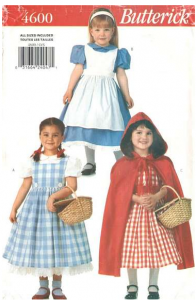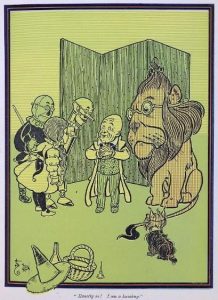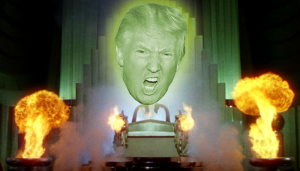
The Wonderful Wizard of Oz written by author L. Frank Baum in 1900 is one of most classic Children’s novel in the United States. Dorothy, a young farm girl from Kansas with her dog Toto, begin the adventures in the magical Land of Oz after they are swept away from home by a cyclone. Similar to other beloved female characters such as Alice who wore puffed sleeve dress with white pleated sweetheart neckline and Little Red Riding Hood who wore the red cape have become classic fashion, Dorothy’s blue and white gingham check dress is also a notable icon. Not to mention that her magic silver slippers (ruby red in the movie in 1939) is as powerful as the magic wand of Cinderella’s Fairy Godmother! The story of The Wonderful Wizard of Oz is an American icon which illustrates the characters’ convinced beliefs of the American dream, represents the populist movement in the late 1800s, and implicates political messages of the current American political landscape.
In the story, Dorothy was told by Witch of the North that she needs to go to the Emerald City in the Land of Oz to seek for help from the Wizard of Oz, who might be able to help her get back home.[1] On her way to the Emerald City, Dorothy became friends with a Scarecrow, a Tin Man and a Cowardly Lion who joined her journey. All of them are pursuing something that would make themselves a better being or for something that they want. Dorothy wants to go home, the Scarecrow is looking for a brain, the Tin Man wants a heart, the Lion wants to obtain courage. Throughout the journey, the Scarecrow he consistently comes up with smart ideas whenever the team faces a challenge, the Tin Man processes emotions through his caring for his friends. He even cries over the death of a beetle, and the Cowardly Lion demonstrates courage when he carries his friends and jumps over deep ditch. During the journey, they fail to realize that they already possess the things they unconsciously want. Rather, they all believe that they are missing something only the great Oz can provide and that they can only achieve their goals in the Emerald City.[2] Even though Oz told them that he cannot grant them their wishes, the Scarecrow, the Tin man and the Lion refused to listen.[3]

The way that they finally arrived at their dream place, the Emerald City in the Land of Oz, after they overcome many challenges is similar to the promise of American dream. If one works hard, anyone can reach the dream of the middle class. They felt satisfied only when Oz provides them with symbolic objects that represent a brain, a heart and courage. Their satisfaction exposes the impact of American dream in their beliefs. They believe that achieving their goals from Oz is the only way to approve their hard work to arrive at Emerald City has pay off. This demonstrates the powerful impact of the American dream, which contribute the novel as an iconic American story.
Another aspect that makes The Wonderful Wizard of Oz an American icon is the Populist elements that implies in the story. In 1964, historian Henry Littlefield points out the novel is an allegory of the Populist movement in the 1890s.[4] The rise of Populist Party was organized by common people such as farmers and factory workers who united to form a third-party to challenge power from bankers and business leaders.[5] Littlefield argues that the Scarecrow in the story represents “self-doubt” American farmers who demonstrate “a terrible sense of inferiority” during this period. [6] The Tin Man symbolizes factory workers who have been dehumanized by the big business. [7] Because there were many Populists advocated the federal government to adopt the monetary policy for free minting silver money during the economic depression in 1893, Littlefield interprets the Oz’s yellow brick road as the existing gold standard and indicates Dorothy’s silver shoes represents the free silver movement.[8]The Wonderful Wizard of Oz is a Populist allegory, which contains elements that reflects the social and political movement in the late 1800s.

The iconic association between the novel and politics is remained today as it has been used to convey messages in current American political climate. Even though everyone believes that Oz is a powerful leader, Dorothy and her friends uncover that the great Wizard of Oz is simply an ordinary man towards the end of the story. He used a variety of tricks that allowed him to be regarded as a powerful Wizard. CNN Journalist Jeanne Moos disapproves the way that the President Donald Trump intended to avoid answering any questions about the Republican tax deduction plan by taping himself talking on two TV screens rather than physically being present during White House press briefing to is similar to Wizard of Oz, who tries to maintain his authority by cunning and avoid presenting his actual appearances in front of the public. [9]In the article “Trump is like ‘Wizard of Oz,’” author Ed Sokalski satirically criticizes the administration of Trump by indicating that his inefficient leadership just as the incapability of Wizard of Oz, an ordinary man with no special power.[10] The story demonstrates the notion of questioning the untruthful leadership has continually being used by political critics today.
The Wonderful Wizard of Oz is an American icon in multiple aspects. The story demonstrates the American belief that hard work pays off. It also highlights the elements of Populist movement, and exposes unreliable leadership, which has remain being used to challenge current political leader.
[1] L. Frank Baum, The Wonderful Wizard of Oz (New York: George M. Hill Company, 1900).
[2] Ibid., 55.
[3] Ibid., 131.
[4] Peter Liebhold, “Populism and the World of Oz,” National Museum of American History.
Smithsonian, November 2, 2016, http://americanhistory.si.edu/blog/populism-oz (accessed February 28, 2018).
[5] Ibid.
[6] Ibid.
[7] Ibid.
[9] “CNN playfully mocks Trump’s ‘Wizard of Oz’ act at the White House press briefing,” The Week, January 5, 2018, http://theweek.com/speedreads/746838/cnn-playfully-mocks-trumps-wizard-oz-act-white-house-press-briefing (accessed February 28, 2018).
[10] Ed Sokalski, “Trump is like ‘Wizard of Oz,’” The Morning Call, February 23, 2018, http://www.mcall.com/opinion/letters/mc-sokalski-trump-wizard-oz-curtain-20180223-story.html (accessed February 28, 2018).